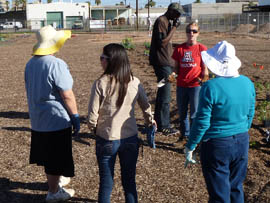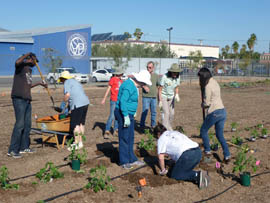Cronkite News has moved to a new home at cronkitenews.azpbs.org. Use this site to search archives from 2011 to May 2015. You can search the new site for current stories.
University of Arizona program involves homeless in community garden
PHOENIX – Kneeling on a patch of soil within sight of downtown, Haley Paul holds a spade in one hand and a potted plant in the other as she instructs a small group clustered in front of her.
“The hole should be as deep as the pot,” she says. “You’re going to have to maybe work the earth a little; it’s a little dry in some parts.”
As an expert on urban agriculture with the University of Arizona’s Cooperative Extension, Paul is used to giving advice on gardening.
But on this day, at a community garden on the Human Services Campus used by social service agencies, her class includes people who are homeless.
The campus established the garden in September on a plot owned by the Society of St. Vincent de Paul, which operates a cafeteria here. UA’s Cooperative Extension, represented by Paul and other volunteers, offers education and management help.
The classes, which take place every few weeks under Paul’s leadership, consist of lessons that participants apply by working in the garden.
Previous sessions covered topics such as tree-staking and irrigation. At the conclusion of each class, participants get a certificate of completion from UA.
Paul said the main goal of Cooperative Extension’s involvement is providing skills that can help participants later.
“We’re coming in to educate, to train them, give them skills, and the endgame we love – they get a job,” she said. “That would be the ultimate impact for us, we want to measure those things. So if you’ve got a job, OK, we’re doing our job.”
David Bridge, managing director of the Human Services Campus, said he hopes the garden helps break what he sees as an “us and them” dynamic of homelessness.
“It’s not about me giving you something, it’s not about me being rich and you being homeless,” he said. “It’s like we’re all working together on one thing, we’re sharing a kind of community experience.”
Although there have been as many as 15 people attending a single class, the recent session on transplanting spring vegetables drew just four.
Participation is a challenge with any community garden, Paul said.
“I think the hardest part is maintaining human capital, maintaining human momentum and enthusiasm as the garden moves on,” she said. “Because it’s exciting to start it and stuff, but what I need most is people that I can rely on consistently to come and help me.
“That’s what is the true mark of a good garden.”
Tony Hunter, who had already attended multiple classes, was among those who showed up for this class. He said his interest stems in part from his affinity for the environment.
“I’m out here because I love nature and I’m Rastafarian and I’ve been down with the Rastas for 40 years,” he said. “Clean air, clean water and live off the land, the Rastafarian way.”
The garden’s harvest – which, after the session on transplants, will include spring vegetables such as tomatoes, cucumbers and squash – will be donated to the campus’ cafeteria.
Jerry Castro, manager of food services for St. Vincent de Paul, said that the kitchen welcomes the crops.
“We couldn’t be happier to see that we’re going to be able to help our guests with a more nutritious salad,” he said.
Micheline Valleau, new programs coordinator for the Human Services Campus, said that the benefits for participants go beyond the certificate.
“A lot of times we’ll find people like that, they kind of think of this as their sanctuary,” she said. “They come here to kind of get away from out there, and they can spend their time and relax.”
Kim, who declined to give her last name, was one of those. She was working in the garden for the first time after deciding it was time to give back, and she said she received quite a bit in return.
“This is going to give me a good memory right here,” she said. “I’m glad I have a good memory of Arizona because there’s not too many of them for the seven years I’ve been here, so I’m very happy.”









